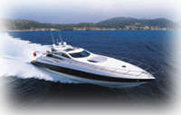PC
Active (NMEA/RS232) Interface Cable
If your system was supplied with
a standard NMEA interface cable (9 pin D type connector and
flying leads), then in all probability it will work well.
However in noisy electrical environments or with long cable
runs problems might be encountered. A solution is to use an
active opto-isolated cable, this also reduces the risk of
damage to your laptop during electrical storms (but can never
fully protect)
Most personal computers communicate with the outside world
via a protocol called RS232. NMEA and RS232 operate on slightly
differing signal voltage levels and with some older equipment
there is a danger of unreliable communication and possible
damage to the computer serial port unless a suitable interface
cable is used. Some GPS manufacturers supply suitable cables
with their devices – if you have one of these, do check
that it is fully opto-isolated and that it protects against
reverse polarity before using it.
The interface cable Euronav supplies allows
bi-directional transfer between NMEA and RS232 protocols,
typically allowing data to come in to the PC from a GPS receiver
or other instrument system, and simultaneously be transmitted
to another device, such as an autopilot. As well as converting
voltage levels between NMEA and RS232 levels, and protecting
against reversed polarity, the listener (input) side is opto-isolated
as per the NMEA specification. The electronics may be powered
from the PC’s serial port, or from the boat’s
12V DC power supply (if your PC is unable to provide sufficient
power). The electronics are housed in a 9-pin "D"
connector, ready to connect to the serial port of most PCs;
the 1m shielded cable has wires at the other end to connect
to your NMEA device(s) and to a 12V power supply (if required).
Note: You will still need the appropriate cable to connect
to the NMEA cable to your GPS,as this is specific to each
GPS model.
|

